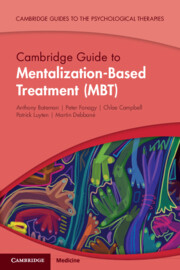Book contents
- Cambridge Guide to Mentalization-Based Treatment (MBT)
- Cambridge Guides to the Psychological Therapies
- Reviews
- Cambridge Guide to Mentalization-Based Treatment (MBT)
- Copyright page
- Contents
- Preface
- A Note from the Series Editor
- Acknowledgments
- Part I Overview of the Model
- Part II The Mentalization-Based Treatment Model in Practice
- Part III Application and Adaptations for Mental Health Presentations
- Chapter 6 Narcissistic Personality Disorder
- Chapter 7 Antisocial Personality Disorder
- Chapter 8 Avoidant Personality Disorder
- Chapter 9 Depression
- Chapter 10 Psychosis
- Chapter 11 Trauma
- Chapter 12 Eating Disorders
- Part IV Application of Mentalization-Based Treatment in Different Populations and in Different Settings
- Index
- References
Chapter 7 - Antisocial Personality Disorder
from Part III - Application and Adaptations for Mental Health Presentations
Published online by Cambridge University Press: 18 May 2023
- Cambridge Guide to Mentalization-Based Treatment (MBT)
- Cambridge Guides to the Psychological Therapies
- Reviews
- Cambridge Guide to Mentalization-Based Treatment (MBT)
- Copyright page
- Contents
- Preface
- A Note from the Series Editor
- Acknowledgments
- Part I Overview of the Model
- Part II The Mentalization-Based Treatment Model in Practice
- Part III Application and Adaptations for Mental Health Presentations
- Chapter 6 Narcissistic Personality Disorder
- Chapter 7 Antisocial Personality Disorder
- Chapter 8 Avoidant Personality Disorder
- Chapter 9 Depression
- Chapter 10 Psychosis
- Chapter 11 Trauma
- Chapter 12 Eating Disorders
- Part IV Application of Mentalization-Based Treatment in Different Populations and in Different Settings
- Index
- References
Summary
Antisocial personality disorder (ASPD) and violence result from a loss of mentalizing. Mentalization-based treatment for antisocial personality disorder (MBT-ASPD) is delivered primarily as a group intervention. Individuals with ASPD are more likely to learn from those whom they consider to be similar to themselves, so the task of the MBT clinician is to generate constructive group interactions during which learning can take place. Common mentalizing profiles of people with ASPD are outlined and examples of the formulation that can be used are given. The chapter discusses how to engage patients in treatment using the formulation, and it provides examples of how to prevent dropout by creating an atmosphere of equality within the group. A range of clinical problems that are commonly encountered when running groups for people with ASPD are outlined, and suggestions on how to intervene in these scenarios are given.
Keywords
- Type
- Chapter
- Information
- Cambridge Guide to Mentalization-Based Treatment (MBT) , pp. 174 - 202Publisher: Cambridge University PressPrint publication year: 2023

